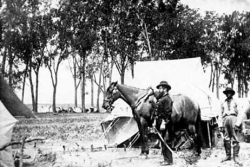Brackett's Battalion
Creator:
Recruited in the fall of 1861, Brackett's Battalion served longer than any other Minnesota unit during the Civil War. After campaigning in the Western Theater, the Battalion participated in the Northwestern Indian Expeditions of 1864 and 1865.
The men of Brackett's Battalion were recruited as the First, Second, and Third Companies of Minnesota Volunteer Cavalry. The captain of the Third Company was Alfred B. Brackett.
During the winter of 1861-1862, the companies were stationed at Benton Barracks near St. Louis, Missouri. Conditions were terrible and many of the men fell ill. The companies were assigned to a cavalry regiment in the Department of the Missouri called the Curtis Horse. Brackett was made major of the Third Battalion, which consisted of four companies.
In February, 1862, the Curtis Horse joined the Union Army of the Tennessee. The regiment was assigned to garrison duty because of its lack of training and weaponry. They garrisoned Forts Henry and Heiman in Tennessee for over a year.
The Curtis Horse did not fight in any major battles, instead serving a supportive role. The Minnesota companies escorted prisoners and dispatch riders. They repaired telegraph lines. Duties also included scouting for enemy forces, and occasionally engaging Confederate guerillas. In June of 1862, the Curtis Horse was renamed the Fifth Iowa Cavalry. Many of the Minnesota soldiers protested this change. They did not want to serve under the name of another state.
In June and July of 1863, the regiment participated in the Tullahoma Campaign. In little more than a week the Army of the Cumberland drove Confederate forces out of middle Tennessee. The Fifth Iowa screened the advance of the army and skirmished with enemy forces. The unit did not stay with the Army of the Cumberland for long. For the rest of the year they were stationed at Murfreesboro, Tennessee and patrolled northern Alabama.
In January of 1864, the unit was sent home on a thirty day furlough. Because of on-going conflicts with the Dakota in the aftermath of the U.S.-Dakota War of 1862, Brackett and Governor Alexander Ramsey arranged for the cavalrymen to be reassigned to the Department of the Northwest. The veteran soldiers were reorganized into a new battalion. New recruits were enlisted to fill the ranks. Major Brackett was given command, giving the unit the official name "Brackett's Battalion."
Brackett's Battalion began the second chapter of its service in February of 1864. The unit joined General Alfred Sully's army for the Northwestern Indian Expedition into Dakota Territory. The expedition was the continuation of a punitive campaign against the Dakota begun in 1863. It was also meant to subjugate any Indians considered hostile to overland routes that led to the gold-bearing headwaters of the Missouri River.
The expedition was punctuated by two battles. On July 28, 1864, Sully's army attacked an encampment composed mostly of Lakota including bands of the Hunkpapa, Sans Arcs, Miniconjous, and Blackfeet. One Wahpekute band of Dakota which had not participated in the U.S.-Dakota War was present as well.
The Indians defended themselves in a battle that lasted several hours, but were eventually defeated by superior firepower. Brackett's Battalion was noted for making a counter charge during the thickest of the fighting. The Battle of Killdeer Mountain ended with Sully's army burning the Indians' homes and the nearby woods.
After the victory, Sully marched south, and then west through the Badlands towards the Yellowstone River. During the march, a three day long skirmish called the Battle of the Badlands was fought. Sully's men were attacked by Lakota from August 7th through 9th. On August 17, Sully's command reached Fort Union. The campaign continued uneventfully for the next two months.
The Battalion's service was not yet over. After spending the winter at Fort Ridgley, the unit was assigned to a second expedition into Dakota Territory. The expedition of 1865 was more peaceful than the previous one, with no major battles. The following winter was spent garrisoning western posts.
In May and June of 1866, the men were finally mustered out. The soldiers of Brackett's Battalion had served a total of four years and nine months.


No comments:
Post a Comment